- Welcome to the Kancolle Wiki!
- If you have any questions regarding site content, account registration, etc., please visit the KanColle Wiki Discord
Difference between revisions of "Glossary"
Jigaraphale (talk | contribs) |
Jigaraphale (talk | contribs) |
||
| Line 1,327: | Line 1,327: | ||
* '''Dragons''' - [[Souryuu]], [[Hiryuu]], and [[Unryuu]], all three being named after dragons | * '''Dragons''' - [[Souryuu]], [[Hiryuu]], and [[Unryuu]], all three being named after dragons | ||
* '''Ducks''' - [[:Category:Akizuki Class|Akizuki-class]] | * '''Ducks''' - [[:Category:Akizuki Class|Akizuki-class]] | ||
| − | * ''' | + | * '''Flamethrower''' - [[Instant Construction Material]] |
* '''Green T''' - Crossing the T (Advantage) [[Day_Battle#Engagement|Engagement]] | * '''Green T''' - Crossing the T (Advantage) [[Day_Battle#Engagement|Engagement]] | ||
* '''Kancolle''' - Kantai Collection | * '''Kancolle''' - Kantai Collection | ||
Revision as of 21:41, 6 January 2022
| Basic Tutorial Portal |
|---|
| Setup and Registration (PC) · Kancolle Android Version · Connection · Troubleshooting · Basic Gameplay · FAQ · Glossary |
| Other Tutorials & Help pages |
Class classification
All ship class codes on the list are based on USN hull classification codes or modifications thereof.
| Terms | In-game Code | Japanese Name | English Name | |
|---|---|---|---|---|
| Kanji | Romaji | |||
| DD | 駆逐 | 駆逐艦 | Kuchikukan | Destroyer |
| DE | 海防 | 海防艦 | Kaiboukan | Destroyer escort/coastal defence ship* |
| SS | 潜 | 潜水艦 | Sensuikan | Submarine |
| SSV* | 潜母 | 潜水空母 | Sensuikūbo | Submarine Aircraft Carrier* |
| CL | 軽巡 | 軽巡洋艦 | Kei Jun'yōkan | Light Cruiser |
| CLT* | 雷巡 | 重雷装巡洋艦 | Jūraisō Jun'yōkan | Torpedo Cruiser* |
| CT* | 練巡 | 練習巡洋艦 | Renshū Jun'yōkan | Training Cruiser* |
| CA | 重巡 | 重巡洋艦 | Jū Jun'yōkan | Heavy Cruiser |
| CAV* | 航巡 | 航空巡洋艦 | Kōkū Jun'yōkan | Aviation Cruiser* |
| AV | 水母 | 水上機母艦 | Suijōkibokan | Seaplane Tender |
| CV/CVB/CVL | - | 正規空母 | Sei'ki kūbo | Fleet Carrier |
| CVL | 軽母 | 軽空母 | Kei kūbo | Light Aircraft Carrier |
| CV | 航 | 航空母艦 | Kōkū bokan | Standard Aircraft Carrier |
| CVB | 装母 | 装甲空母 | Sōkō kūbo | Armored Aircraft Carrier* |
| BB | 戦 | 戦艦 | Senkan | Battleship |
| FBB* | 戦 | 高速戦艦 | Kōsoku Senkan | Fast Battleship* |
| BBV* | 航戦 | 航空戦艦 | Kōkū Senkan | Aviation Battleship* |
| LHA* | 揚陸 | ドック型揚陸艦 | Dokkugata Yōrikukan | Amphibious Assault Ship* |
| AR | 工 | 工作艦 | Kōsakukan | Repair Ship |
| AS | 潜母艦 | 潜水母艦 | Sensui bokan | Submarine Tender |
| AO | 補給 | 給油艦 | Kyūyukan | Fleet Oiler |
- Note
- In Kancolle, "coastal defense ships" are labeled as "DE" and "destroyers escort" as DD and not DE.
- The term Kūbo (空母?) is a shorthand for Kōkū bokan (航空母艦?), which means "Aircraft Carrier".
- In-game, the cards & encyclopedia have the ship class English Name, but some are rendered differently from above.
- "Aircraft Carrying Submarine" instead of "Submarine Aircraft Carrier"
- "Aircraft Cruiser" instead of "Aviation Cruiser"
- "Seaplane Carrier" instead of "Seaplane Tender"
- "Aircraft Carrier" instead of "Standard Aircraft Carrier"
- "Aircraft Carrier" instead of "Armored Aircraft Carrier"
- "Battleship" instead of "Fast Battleship"
- There are no USN hull classification codes for:
- Submarine Aircraft Carriers
- Training Cruisers
- Torpedo Cruisers
- Aviation Cruisers
- Armored Carriers
- KanColle fans occasionally use CVB, which was for the largest aircraft carriers, such as Shinano.
- Fast Battleships
- Aviation Battleships
- Landing Craft Carriers (Amphibious Assault Ship)
General
API link
- For more information on this topic, see Play without VPN/Proxy.
A method to play the game without having to access the official DMM website.
Crossing the T
Classic naval strategy in which a line of warships cross in front of a line formation of enemy ships, allowing the crossing line to bring all their guns to bear while receiving fire from only the forward guns of the enemy. Gameplay-wise, when your fleet crosses the enemy fleet, both sides (counter-intuitively) gain a significant increase in firepower. When the opponent crosses your fleet, both sides receive a significant firepower debuff.
Docking
- For more information on this topic, see Docking.
This allows your damaged ships to be repaired to full health by consuming steel and fuel. You can use an instant repair (高速修復材) to immediately finish.
Expedition
- For more information on this topic, see Expedition.
This is where you send your fleets to complete expeditions, in exchange for resources and certain items. Certain ships and equipment can be obtained exclusively through expeditions.
Food supply ship Mamiya
- For more information on this topic, see Morale/Fatigue.
This item removes any fatigue on your fleet. See here for the Wikipedia entry.
Modernization
- For more information on this topic, see Modernization.
The process of using spare ships to increase the stats (firepower, AA, torpedo, armor) of ships up to a certain point. Luck can also be modernized with Maruyu, but she is difficult to obtain.
- For more information on this topic, see Exercises (PvP).
These are battles against other players' fleets. Opposing teams update in real-time, but there is no simultaneous play.
- New opponent list refreshed at 03:00 and 15:00 JST
Phases of Battle
- For more information on this topic, see Combat.
- Day Battle
- Reconnaissance (Stat boost, avoid being T-crossed)
- Initial airstrike (opening bombing, air superiority)
- Support fleet attack
- Opening/initial torpedo strike (see Type A Ko-hyoteki (甲標的甲型))
- Shelling/artillery phase (regular airstrike happens here)
- Torpedo salvo
- Night Battle
Remodel
- For more information on this topic, see Remodel.
Often confused with Modernization, will usually result in *ship name*-Kai (改). also known as Upgrading.
Fatigue
- For more information on this topic, see Alright, I built my ship, kicked some ass and I noticed the orange faces. What gives?.
Orange/sad faces are displayed next to the ship icon if they are too fatigued. Rest them for 15 minutes or so if it happens. Fatigue will reduce by 3 every 3 minutes. Fatigued ships will have lower accuracy and evasion. If your ships are still fatigued upon returning from expedition, your expedition will end up failing even with all other criteria fulfilled.
Sparkle
- For more information on this topic, see My ship is sparkling/glittering!.
The polar opposite of Fatigue. If one or more of your ships sparkle, they will gain evasion boost during sortie. The evasion boost stats are not shown in your ship stats directly. Or, if you choose to send a sparkling ship on an expedition, it will have a chance for 150% resource gain and a higher likelihood of returning with a special item (note that this requires the entire fleet to be consisting of sparkling ships).
Medal
- For more information on this topic, see Blueprint.
Medals (勲章?) are a multi-purpose item that can be used to exchange for a small amount of resources or a remodel blueprint (改装設計図?).
- 1 medal can be used to exchange for
 x300,
x300,  x300,
x300,  x300,
x300,  x300 and
x300 and  x2.
x2. - 1 medal can also be used to exchange for Improvement Materials
 x4.
x4. - 4 medals are needed to exchange for 1 x remodel blueprint.
Medals can be obtained by clearing certain maps. You can find the amount of medals owned by accessing the Item page(アイテム) at the top menu bar of the main screen. Remodel blueprint is needed to remodel certain ships.
Tracer-fire effect
This occurs when a ship fires any equipped machine guns to defend itself, reducing incoming damage from enemy bombers. Your flagship will always do this by default, even without any anti-air stat.
Equipment Icons
Carriers planes
 Red Plane: Carrier-based Dive Bomber. Have a strong shelling-phase attack, and prevent Installations from being attacked.
Red Plane: Carrier-based Dive Bomber. Have a strong shelling-phase attack, and prevent Installations from being attacked. Blue Plane: Carrier-based Torpedo Bomber. Have a strong preliminary attack, and can attack Installations.
Blue Plane: Carrier-based Torpedo Bomber. Have a strong preliminary attack, and can attack Installations.
 Dark-blue Plane 1: Night battle capable Carrier-based Torpedo Bomber
Dark-blue Plane 1: Night battle capable Carrier-based Torpedo Bomber
 Green Plane: Carrier-based Fighters provide air superiority and shoot down opposing aircraft.
Green Plane: Carrier-based Fighters provide air superiority and shoot down opposing aircraft.
 Dark-blue Plane 2: Night battle capable Carrier-based Fighters
Dark-blue Plane 2: Night battle capable Carrier-based Fighters
 Yellow Plane: Carrier-based Recon Aircraft boost accuracy and LOS greatly.
Yellow Plane: Carrier-based Recon Aircraft boost accuracy and LOS greatly.
 Yellow Jets planes : Carrier-based Jets. They provide air superiority, have a shelling-phase attack, and also carry an initial "Jet Assault"
Yellow Jets planes : Carrier-based Jets. They provide air superiority, have a shelling-phase attack, and also carry an initial "Jet Assault"
Seaplanes
 Light Green Plane: Seaplanes are Reconns or Bombers, and are equipable by a wide variety of ships for both Artillery spotting and participation in Air Superiority and Bombing.
Light Green Plane: Seaplanes are Reconns or Bombers, and are equipable by a wide variety of ships for both Artillery spotting and participation in Air Superiority and Bombing.
 Flying boats
Flying boats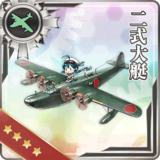
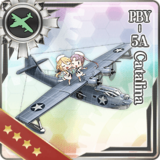 only participate in bombing if other planes are present, and are only equipable by several AVs.
only participate in bombing if other planes are present, and are only equipable by several AVs.
 Light Green Fighter Plane: Fighters equipable by many seaplanes capable ships and act as regular Fighters.
Light Green Fighter Plane: Fighters equipable by many seaplanes capable ships and act as regular Fighters.
 Anti-Submarine Patrol Aircrafts, including Autogyros
Anti-Submarine Patrol Aircrafts, including Autogyros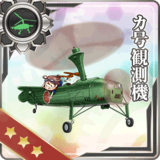
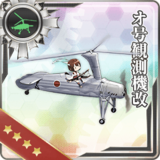
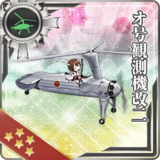 , Helicopters
, Helicopters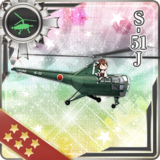
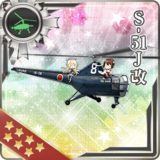 , and ASW Planes
, and ASW Planes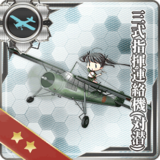 are only useful against Submarines.
are only useful against Submarines.
LBAS planes
 Flying boats
Flying boats
 mostly act as range extenders. [[|]]
mostly act as range extenders. [[|]]
 have an additional crew recovery mechanic.
have an additional crew recovery mechanic. large Green Plane: Landbased Bomber / Attacker
large Green Plane: Landbased Bomber / Attacker very large Green Plane: Landbased Large / High altitude Bomber
very large Green Plane: Landbased Large / High altitude Bomber Bluish Plane: ASW specialized plane
Bluish Plane: ASW specialized plane Green Plane: Interceptor Fighter plane
Green Plane: Interceptor Fighter plane Light Green Plane: Interceptor Fighter plane
Light Green Plane: Interceptor Fighter plane Yellow Plane: Recon Aircraft boost accuracy and LOS greatly and act as range extenders.
Yellow Plane: Recon Aircraft boost accuracy and LOS greatly and act as range extenders.
It is based on their roles, not ability.
- Red Gun: Main Gun; Primarily used against ships, provide a slight AA bonus.
 Light Guns are Destroyer guns, and can be mounted on Destroyers or Light Cruisers or some other ships.
Light Guns are Destroyer guns, and can be mounted on Destroyers or Light Cruisers or some other ships. Medium Guns Are Cruiser guns, and can be mounted on Light Cruisers, Heavy Cruisers, or some other heavy ships.
Medium Guns Are Cruiser guns, and can be mounted on Light Cruisers, Heavy Cruisers, or some other heavy ships. Heavy Guns are Battleship guns, and can only be mounted on Battleships. Depending on the caliber of the gun, and the ship equipped, there can be either accuracy bonuses or severe mounting penalties.
Heavy Guns are Battleship guns, and can only be mounted on Battleships. Depending on the caliber of the gun, and the ship equipped, there can be either accuracy bonuses or severe mounting penalties.
 Yellow Gun: Secondary Guns increase accuracy and AA stats, and also trigger some combat mechanics. They can be equipped by Light Cruisers, Heavy Cruisers, Battleships, and Aircraft Carriers.
Yellow Gun: Secondary Guns increase accuracy and AA stats, and also trigger some combat mechanics. They can be equipped by Light Cruisers, Heavy Cruisers, Battleships, and Aircraft Carriers.- Green Gun: High-angle dual-purpose guns or AA machine guns:
 High-angle guns have the ability to effectively attack both aircraft and ships (some are "Light Main Guns" and other "Secondary Guns").
High-angle guns have the ability to effectively attack both aircraft and ships (some are "Light Main Guns" and other "Secondary Guns"). AA machine guns specifically attack aircraft and always trigger tracer-fire effect.
AA machine guns specifically attack aircraft and always trigger tracer-fire effect.
Torpedoes
 Torpedoes are equippable on Destroyers, Cruisers, Submarines, and some Battleships.
Torpedoes are equippable on Destroyers, Cruisers, Submarines, and some Battleships.
- Bow and stern torpedo launchers are exclusive to Submarines
- Midget Submarine
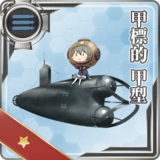
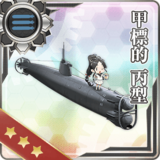
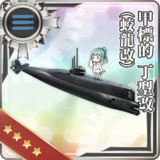 , are mini-submarines equipable on Torpedo Cruisers and Submarines, and on some Seaplane Tenders, Light Cruisers and Heavy Cruisers. When equipped, they trigger an opening torpedo.
, are mini-submarines equipable on Torpedo Cruisers and Submarines, and on some Seaplane Tenders, Light Cruisers and Heavy Cruisers. When equipped, they trigger an opening torpedo.
Anti-Submarine Warfare
 Depth Charges and Depth Charges Launchers provide a bonus to ASW.
Depth Charges and Depth Charges Launchers provide a bonus to ASW. SONARs provides both an accuracy bonus and a bonus to ASW.
SONARs provides both an accuracy bonus and a bonus to ASW.- Combining some ASW equipment gives ASW Damage Synergy
 RADARs provide increased accuracy, and also help against aircraft
RADARs provide increased accuracy, and also help against aircraft Submarine Radars
Submarine Radars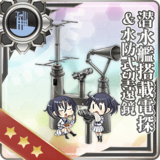
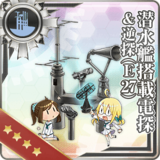
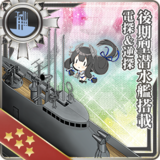 are exclusive to submarines and have a similar effect as regular radars.
are exclusive to submarines and have a similar effect as regular radars.- Night Battle Equipment:
 Searchlights
Searchlights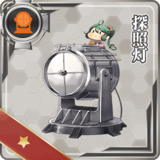
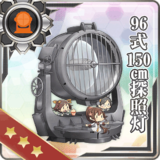 provide an accuracy boost but result in the ship carrying them being targeted.
provide an accuracy boost but result in the ship carrying them being targeted. Star Shells
Star Shells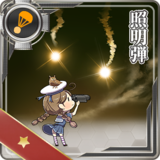 reduce the enemy cut-in chance and increase allied cut-in rates.
reduce the enemy cut-in chance and increase allied cut-in rates.
 Skilled Lookouts
Skilled Lookouts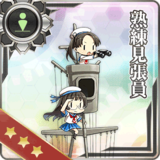
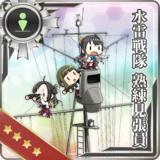 increase the cut-in chance and accuracy against light enemies and unlock new cut-ins.
increase the cut-in chance and accuracy against light enemies and unlock new cut-ins. Landing Crafts
Landing Crafts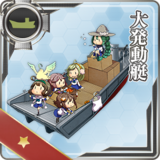
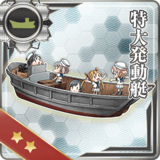 and armed boat
and armed boat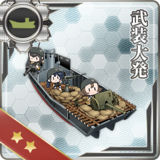
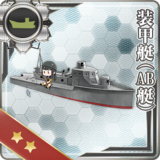 boost expedition returns, are utilized in transport operations, and with landing tanks
boost expedition returns, are utilized in transport operations, and with landing tanks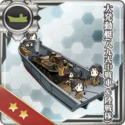
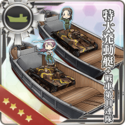
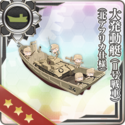
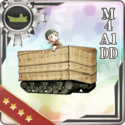
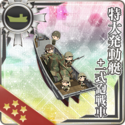 , they are also useful against enemy installations.
, they are also useful against enemy installations.
 Tanks
Tanks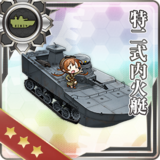 are useful against installations and give a small resource gain bonus.
are useful against installations and give a small resource gain bonus.
 Drums
Drums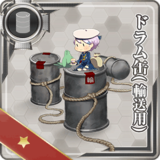 are needed for some expeditions and Transport Operations.
are needed for some expeditions and Transport Operations. Underway Replenishment
Underway Replenishment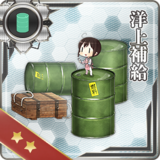 allows for AO to restore fuel and ammo to ships during a sortie and serve the same role as Drums during Transport Operations.
allows for AO to restore fuel and ammo to ships during a sortie and serve the same role as Drums during Transport Operations. AA Fire Directors
AA Fire Directors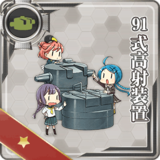
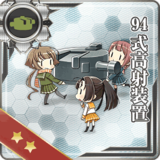 allow the use of AACIs in combination with High-Angle guns.
allow the use of AACIs in combination with High-Angle guns. The Fleet Command Facility
The Fleet Command Facility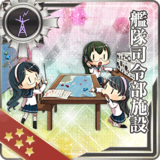 , Striking Force Fleet Command Facility
, Striking Force Fleet Command Facility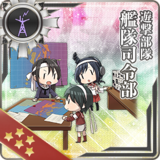 and Elite Torpedo Squadron Command Facility
and Elite Torpedo Squadron Command Facility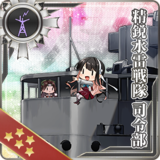 allow for ships in a combined fleet, strike force, or DD fleets respectively to retreat when critically damaged.
allow for ships in a combined fleet, strike force, or DD fleets respectively to retreat when critically damaged. Turbines
Turbines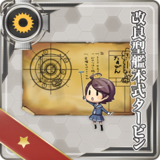 and boilers
and boilers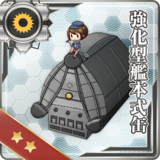
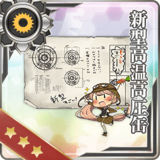 can be equipped on any ship. They increase evasion, and when combined, also provide a boost to ship's speed.
can be equipped on any ship. They increase evasion, and when combined, also provide a boost to ship's speed. AA Shells
AA Shells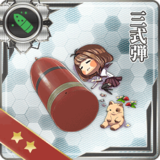
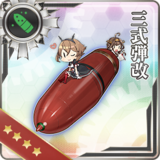 confer a small AA bonus, but are primarily utilized against soft Installations.
confer a small AA bonus, but are primarily utilized against soft Installations. AP Shells
AP Shells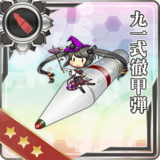
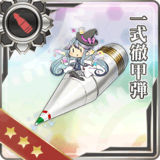
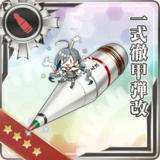 increase firepower, allow for AP Cut-Ins and confer an additional post-cap firepower bonus against most hard targets.
increase firepower, allow for AP Cut-Ins and confer an additional post-cap firepower bonus against most hard targets. The Rocket Launchers
The Rocket Launchers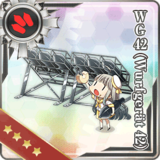
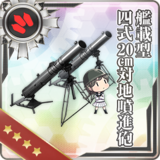
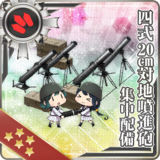 confer a flat firepower bonus against installation targets.
confer a flat firepower bonus against installation targets. Damage control
Damage control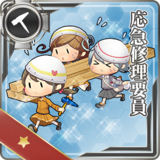
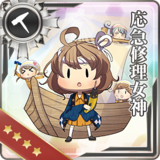 items are single-use and prevent ships from sinking.
items are single-use and prevent ships from sinking. Torpedo Bulges increase armor at a small evasion cost
Torpedo Bulges increase armor at a small evasion cost The Ship Repair Facility
The Ship Repair Facility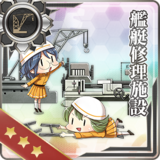 allows Akashi and Akitsushima, to repair a ship when set as secretary for the former, and repain in sortie for both.
allows Akashi and Akitsushima, to repair a ship when set as secretary for the former, and repain in sortie for both. aviation-related special equipements:
aviation-related special equipements:
- Skilled Carrier-based Aircraft Maintenance Personnel
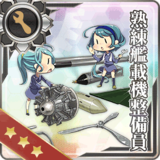 (SCAMP) extends the range of carriers, allowing them to attack earlier in the shelling phase
(SCAMP) extends the range of carriers, allowing them to attack earlier in the shelling phase - Night Personnel
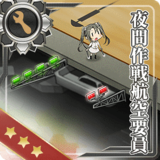
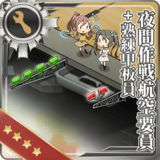 (NOAP) allow carriers to shell at night when equipped with a night-operations capable plane
(NOAP) allow carriers to shell at night when equipped with a night-operations capable plane - Arctic Gear & Deck Personnel
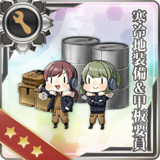 (AGDP) is needed for CV/CVB/CVL to sortie in "Arctic Maps"
(AGDP) is needed for CV/CVB/CVL to sortie in "Arctic Maps"
- Skilled Carrier-based Aircraft Maintenance Personnel
 Rations
Rations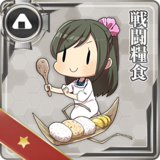
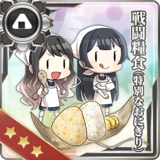
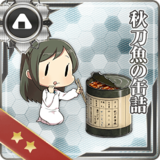 restore morale during sorties.
restore morale during sorties. Saiun (Disassembled for Transport)
Saiun (Disassembled for Transport)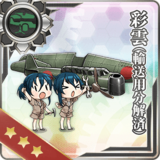
IJN ship-naming conventions
- Destroyers are named after natural phenomena, often snow (雪, "-yuki"), waves (波, "-nami"), rain (雨, "-ame", "-are"), wind (風, "-kaze"), clouds (雲, "-kumo" or "-gumo"), the moon (月, "-tsuki" or "-zuki") or tides (潮, "-shio").
- Light Cruisers are named after rivers.
- Heavy Cruisers are named after mountains.
- Exceptions: The Mogami class were originally designed as Light Cruisers before being extensively modified into Heavy Cruisers (and later Aviation Cruisers), and so are named after rivers. The Tone class also, being more lightly armed than the Takao or Myoukou classes, were also named after rivers.
- Battleships are named after provinces.
- Exceptions: The Kongou class were originally designed as Battlecruisers, which were named after mountains before "heavy cruiser" became a separately defined class from simply "cruiser".
- Aircraft Carriers all have the character for "dragon" (龍, "ryuu"), "phoenix" (鳳, "hou"), "crane" (鶴, "kaku") or "falcon" (鷹, "you") in them. Light carriers tend to have "falcon" or "phoenix" names, where Fleet carriers tend to have "dragon" or "crane" names, but this is not strict.
- Exceptions: Akagi and Kaga were originally designed as a battlecruiser and a battleship, respectively, and follow those classes' naming conventions instead (Akagi is named after a mountain, Kaga is named after a province). Chitose and Chiyoda were not originally aircraft carriers, their names are poetic words for "millenium".
- While Taigei's name was changed to fit in with the standard Aircraft Carrier naming scheme ("Ryuuhou" means "Dragon Phoenix") when she was remodeled into an Aircraft Carrier, neither Chitose nor Chiyoda received the same treatment when they were remodeled.
- Submarines are simply given operating numbers in the same manner as German U-boats, following a syllable of the word 'Iroha'. All long-range submarines were designated 'I-' (such as all the submarines present in KanColle), where coastal subs began with 'Ro' and training submarines were 'Ha-' In Kancolle, the submarine girls use the classical japanese number syllables (or just the number directly, in I-8's case) to make their numbers sound more name-like.
- Submarine Tenders were a varied group of ships. Several of these had the character for "whale" (鯨, "gei") in their names, but many did not.
- Shouhou and Zuihou were originally designed as Submarine Tenders before being converted into Light Carriers. Like Ryuuhou, their names were changed upon conversion, they were originally named Tsurugizaki and Takasaki.
- Non-Navy Ships' names were often appended with "Maru" (丸) the character for 'circle'. The reason for this tradition seems to have been lost to time, but may be related to the red circle being the symbol and flag of japan (the "hi-no-maru") or as a superstition, helping ships travel a circle of going out to sea and returning home.
- The examples in KanColle are "Akitsumaru" (an Army ship) and both Hiyou and Junyou's names before they were converted to aircraft carriers: Izumo Maru and Kashiwara Maru.
- The "maru" in "Maruyu" is a reference to this character, but does not actually appear in her name, which is a circle around the hiragana character 'yu'.
- Akashi was named after the Akashi Strait, near Kobe. Since she was the only repair ship built for the IJN, the naming conventions of her class are unclear.
The Abyssal fleet's 'classes' are the based on the Iroha, a classical Japanese alphabetical ordering. That this is classical Japanese implies that the classes are externally ascribed to the Abyssal fleet ships, especially combined with the highly descriptive names for the bosses.
Birthdays of Ship Girls
The date a ship was launched is traditionally used as a ship's birthday; the dates presented here reflect this. These dates are sourced from Wikipedia.
| # | Coastal defence ships(by class) | Date Launched |
|---|---|---|
| # | Shimushu-class | Date Launched |
| 1st | Shimushu | xx |
| 2nd | Kunashiri | xx |
| 3rd | Hachijou | xx |
| 4th | Ishigaki | xx |
| # | Etorofu-class | Date Launched |
| 1st | Etorofu | x |
| 2nd | Matsuwa | xx |
| 3rd | Sado | xx |
| 7th | Tsushima | xx |
| 9th | Hirato | xx |
| 10th | Fukae | xx |
| # | Mikura-class | Date Launched |
| 1st | Mikura | xx |
| 7th | Yashiro | xx |
| # | Hiburi -subclass | Date Launched |
| 1st | Hiburi | xx |
| xnd | Hiburi | xx |
| xrd | Shounan | xx |
| # | Type D | Date Launched |
| 4th | Kaiboukan No.4 | xx |
| 30rd | Kaiboukan No.30 | xx |
| # | Destroyers (by class) | Date Launched |
|---|---|---|
| # | Kamikaze-class | Date Launched |
| 1st | Kamikaze | xx |
| xnd | Asakaze | xx |
| xrd | Harukaze | xx |
| xth | Matsukaze | xx |
| xth | Hatakaze | xx |
| # | Mutsuki-class | Date Launched |
| 1st | Mutsuki | 23 July 1925 |
| 2nd | Kisaragi | 5 June 1925 |
| 3rd | Yayoi | 11 July 1925 |
| 4th | Uzuki | 15 October 1925 |
| 5th | Satsuki | 25 March 1925 |
| xth | Minazuki | xx |
| 7th | Fumizuki | 16 February 1926 |
| 8th | Nagatsuki | 6 October 1926 |
| 9th | Kikuzuki | 15 March 1926 |
| 10th | Mikazuki | 12 July 1926 |
| 11th | Mochizuki | 28 April 1927 |
| # | Fubuki-class | Date Launched |
| 1st | Fubuki | 15 November 1927 |
| 2nd | Shirayuki | 20 March 1928 |
| 3rd | Hatsuyuki | 29 September 1928 |
| 4th | Miyuki | 26 June 1928 |
| 5th | Murakumo | 27 September 1928 |
| xth | Usugumo | xx |
| 9th | Isonami | 24 November 1927 |
| xth | Uranami | xx |
| # | Ayanami-class | Date Launched |
| 11th | Ayanami | 5 October 1929 |
| 12th | Shikinami | 22 June 1929 |
| xth | Amagiri | xx |
| xth | Sagiri | xx |
| 17th | Oboro | 8 November 1930 |
| 18th | Akebono | 7 November 1930 |
| 19th | Sazanami | 31 June 1931 |
| 20th | Ushio | 17 November 1930 |
| # | Akatsuki-subclass | Date Launched |
| 1st | Akatsuki | 7 May 1932 |
| 2nd | Hibiki | 22 December 1932 |
| 3rd | Ikazuchi | 22 October 1931 |
| 4th | Inazuma | 25 February 1932 |
| # | Hatsuharu-class | Date Launched |
| 2nd | Hatsuharu | 27 February 1933 |
| 3rd | Hatsushimo | 4 November 1933 |
| 4th | Nenohi | 22 December 1932 |
| 5th | Wakaba | 18 March 1934 |
| xth | Ariake | xx |
| # | Shiratsuyu-class | Date Launched |
| 1st | Shiratsuyu | 5 April 1935 |
| 2nd | Shigure | 18 May 1935 |
| 3rd | Murasame | 20 June 1935 |
| 4th | Yuudachi | 21 June 1936 |
| 5th | Samidare | 6 July 1935 |
| 6th | Harusame | 21 September 1935 |
| xth | Umikaze | xx |
| xth | Yamakaze | xx |
| xth | Kawakaze | xx |
| 10th | Suzukaze | 11 March 1937 |
| # | Asashio-class | Date Launched |
| 1st | Arare | 16 November 1937 |
| 2nd | Arashio | 26 May 1937 |
| 3rd | Asagumo | 5 November 1937 |
| 4th | Asashio | 16 December 1936 |
| 5th | Kasumi | 18 November 1937 |
| 6th | Michishio | 15 March 1937 |
| 9th | Ooshio | 19 April 1937 |
| 10th | Yamagumo | 24 July 1937 |
| xth | Asagumo | xx |
| xth | Minegumo | xx |
| # | Kagerou-class | Date Launched |
| 1st | Akigumo | 11 April 1941 |
| 2nd | Amatsukaze | 19 October 1939 |
| 5th | Hamakaze | 25 November 1940 |
| 6th | Hatsukaze | 24 January 1939 |
| 8th | Isokaze | 19 June 1939 |
| 9th | Kagerou | 27 September 1938 |
| 10th | Kuroshio | 25 October 1938 |
| 11th | Maikaze | 15 March 1941 |
| 13th | Nowaki | 17 September 1940 |
| 15th | Shiranui | 28 June 1938 |
| 16th | Tanikaze | 1 November 1940 |
| 17th | Tokitsukaze | 10 November 1939 |
| 18th | Urakaze | 19 April 1940 |
| 19th | Yukikaze | 24 March 1939 |
| xth | Oyashio | x |
| xth | Arashi | x |
| xth | Hagikaze | xx |
| # | Yuugumo-class | Date Launched |
| 2nd | Asashimo | 21 January 1943 |
| 6th | Hayashimo | 20 October 1943 |
| 10th | Kiyoshimo | 16 March 1943 |
| 11th | Makigumo | 23 December 1940 |
| 12th | Naganami | 11 April 1941 |
| 19th | Yuugumo | 16 March 1941 |
| xth | Kazagumo | xx |
| xth | Makinami | xx |
| xth | Takanami | xx |
| xth | Suzunami | xx |
| xth | Fujinami | xx |
| xth | Hayanami | xx |
| xth | Hamanami | xx |
| xth | Okinami | xx |
| xth | Kishinami | xx |
| xth | Asashimo | xx |
| xth | Akishimo | xx |
| # | Akizukiclass | Date Launched |
| 1st | Akizuki | 2 July 1941 |
| 2nd | Teruzuki | xx |
| 3rd | Suzutsuki | xx |
| 4th | Hatsuzuki | xx |
| # | Matsu-class | Date Launched |
| 1st | Matsu | xx |
| 2nd | Take | xx |
| 4th | Momo | xx |
| # | Others | Date Launched |
| 1st | Shimakaze | 18 July 1942 |
| 1st | Z1 | xx |
| 3rd | Z3 | xx |
| 1st | Maestrale | xx |
| 2nd | Grecale | xx |
| 3rd | Libeccio | xx |
| 4th | Scirocco | xx |
| 1st | Fletcher | xx |
| 112th | Johnston | xx |
| 74th | Samuel B. Roberts | xx |
| 1st | Jervis | xx |
| 5th | Janus | xx |
| 1st | Tashkent | xx |
| # | Light Cruisers | Date Launched |
|---|---|---|
| # | Tenryuu-Class | Date Launched |
| 1st | Tenryuu | 11 March 1918 |
| 2nd | Tatsuta | 29 May 1918 |
| # | Kuma-Class | Date Launched |
| 1st | Kuma | 14 July 1919 |
| 2nd | Tama | 10 February 1920 |
| 3rd | Kitakami | 3 July 1920 |
| 4th | Ooi | 15 July 1920 |
| 5th | Kiso | 14 December 1920 |
| # | Nagara-Class | Date Launched |
| 1st | Nagara | 25 April 1922 |
| 2nd | Isuzu | 29 October 1921 |
| 3rd | Natori | 16 February 1922 |
| 4th | Yura | 15 February 1922 |
| 5th | Kinu | 29 May 1922 |
| 6th | Abukuma | 16 March 1923 |
| # | Sendai-Class | Date Launched |
| 1st | Sendai | 30 October 1923 |
| 2nd | Jintsuu | 8 December 1923 |
| 3rd | Naka | 24 March 1925 |
| # | Agano-Class | Date Launched |
| 1st | Agano | 22 October 1941 |
| 2nd | Noshiro | 19 July 1942 |
| 3rd | Yahagi | 25 October 1942 |
| 4th | Sakawa | 9 April 1944 |
| # | Katori-Class | Date Launched |
| 1st | Katori | 14 December 1939 |
| 2nd | Kashima | 25 September 1939 |
| Other | Date Launched | |
| Yuubari | 5 March 1923 | |
| Ooyodo | 2 April 1942 | |
| Duca degli Abruzzi | xx | |
| Giuseppe Garibaldi | xx | |
| Honolulu | xx | |
| Helena | xx | |
| Atlanta | xx | |
| Sheffield | xx | |
| Gotland | xx | |
| De Ruyter | xx | |
| Perth | xx |
| # | Heavy Cruisers | Date Launched |
|---|---|---|
| # | Furutaka-Class | Date Launched |
| 1st | Furutaka | 25 February 1925 |
| 2nd | Kako | 10 April 1925 |
| # | Aoba-Class | Date Launched |
| 1st | Aoba | 25 September 1926 |
| 2nd | Kinugasa | 24 October 1926 |
| # | Myoukou-Class | Date Launched |
| 1st | Myoukou | 16 April 1927 |
| 2nd | Nachi | 15 June 1927 |
| 3rd | Ashigara | 22 April 1928 |
| 4th | Haguro | 24 March 1928 |
| # | Takao-Class | Date Launched |
| 1st | Takao | 12 May 1930 |
| 2nd | Atago | 16 June 1930 |
| 3rd | Maya | 8 November 1930 |
| 4th | Choukai | 30 June 1931 |
| # | Mogami-Class | Date Launched |
| 1st | Mogami | 14 March 1934 |
| 2nd | Mikuma | 31 May 1934 |
| 3rd | Suzuya | 20 November 1934 |
| 4th | Kumano | 15 October 1936 |
| # | Tone-Class | Date Launched |
| 1st | Tone | 21 November 1937 |
| 2nd | Chikuma | 19 March 1938 |
| # | Admiral Hipper-Class | Date Launched |
| 3rd | Prinz Eugen | 22 August 1938 |
| Other | Date Launched | |
| Zara | xx | |
| Pola | xx | |
| Northampton | xx | |
| Houston | xx |
| Battleships | Date Launched |
|---|---|
| Nagato | 9 November 1919 |
| Mutsu | 31 May 1920 |
| Kongou | 18 May 1912 |
| Hiei | 21 November 1912 |
| Kirishima | 1 December 1913 |
| Haruna | 14 December 1913 |
| Fusou | 28 March 1914 |
| Yamashiro | 3 November 1915 |
| Ise | 12 November 1916 |
| Hyuuga | 27 January 1917 |
| Yamato | 8 August 1940 |
| Musashi | 1 November 1940 |
| Bismarck | 14 February 1939 |
| Conte di Cavour | xx |
| Littorio | xx |
| Roma | xx |
| Colorado | xx |
| Washington | xx |
| South Dakota | xx |
| Iowa | xx |
| Warspite | xx |
| Nelson | xx |
| Richelieu | xx |
| Gangut | xx |
| Light Carriers | Date Launched |
|---|---|
| Houshou | 13 November 1921 |
| Ryuujou | 2 April 1931 |
| Hiyou | 24 June 1941 |
| Junyou | 26 June 1941 |
| Shouhou | 1 June 1935 |
| Zuihou | 19 June 1936 |
| Kasuga Maru | xx |
| Shinyou | xx |
| Gambier Bay | xx |
| Standard Carriers | Date Launched |
|---|---|
| Akagi | 22 April 1925 |
| Kaga | 17 November 1921 |
| Souryuu | 21 December 1935 |
| Hiryuu | 16 November 1937 |
| Shoukaku | 1 June 1939 |
| Zuikaku | 27 November 1939 |
| Taihou | 7 March 1943 |
| Unryuu | 25 September 1943 |
| Amagi | 1 October 1943 |
| Katsuragi | xx |
| Graf Zeppelin | xx |
| Aquila | xx |
| Saratoga | xx |
| Intrepid | xx |
| Hornet | xx |
| Ark Royal | xx |
| Victorious | xx |
| Submarines | Date Launched |
|---|---|
| I-8 | 20 July 1936 |
| I-19 | 16 September 1939 |
| I-26 | xx |
| I-168 | 26 June 1933 |
| I-58 | 30 June 1943 |
| I-400 | xx |
| I-401 | 8 January |
| I-13 | xx |
| I-14 | xx |
| I-47 | xx |
| I-203 | xx |
| Maruyu | 31 October |
| U-511 | 21 Febuary 1941 |
| Luigi Torelli | xx |
| Scamp | xx |
| Auxiliary ships | Date Launched |
|---|---|
| Seaplane Tender | |
| Akitsumaru | 24 Sept 1941 |
| Chitose | xx |
| Chiyoda | xx |
| Mizuho | xx |
| Nisshin | xx |
| Commandant Teste | xx |
| Fleet Oiler | |
| Kamoi | xx |
| Hayasui | xx |
| Souya | xx |
| Amphibious Assault Ship | |
| Shinshuu Maru | xx |
| Akitsu Maru | xx |
| Submarine Tender | |
| Taigei | 16 November 1933 |
| Jingei | xx |
| Chougei | xx |
| others | |
| Akashi | 29 June 1938 |
| Mamiya | 26 October 1923 |
| Irako | 14 February 1941 |
List of vessels by Japanese voice actresses
List of vessels by artist
List of music by composers
| Composer | Tracks |
|---|---|
| Okamiya Michio (岡宮道生) | Game, Event, OST -Akatsuki-, Incomplete |
| Ookoshi Kaori ( 大越香里) | Game, Event, OST -Akatsuki-, Incomplete |
| Usami Hiroshi (宇佐美宏) | Game, Event, OST -Akatsuki-, Incomplete |
| Uncredited | Japanese wiki |
Acronyms
Ever see an acronym in the wiki you didn't know the meaning of and urban dictionary doesn't have it? While it is preferable to not use acronyms to avoid confusion, some discussions will inevitably have them. This is an incomplete list of acronyms used in discussions by English-speaking KanColle players.
- AA - Anti-Air
- AACI - Anti-Air Cut-in
- ABKM - Abukuma
- ACH - Aircraft Carrier Hime
- AD - Air Denial
- AFP - Air Fighter Power
- AGB - Icebreaker
- AGDP - Arctic Gear & Deck Personnel

- AGL - Lighthouse tender
- AGS - Survey ship
- AI - Air Incapability
- AO - Fleet Oiler / Replenishment Oiler
- AP :
- AP - Air Parity
- AP - Air Power
- AP - Armor Piercing
- AR :
- AR - Repair Ship
- AR - Action Report
- AS :
- AS - Submarine Tender
- AS - Artillery Spotting
- AS - Air Superiority
- AS+ - Air Supremacy
- ASW - Anti-Submarine Warfare
- AV - Seaplane Tender
- BB - Battleship
- BBV - Aviation Battleship
- BP - Blueprint
- CA - Heavy Cruiser
- CAV - Aviation Cruiser
- CF - Combined Fleet
- CI - Cut-In
- CL - Light Cruiser
- CLT - Torpedo Cruiser
- CT :
- CT - Training Cruiser
- CT - Closing Torpedo
- CTF - Carrier Task Force
- CV :
- CV - Character Voice, same as VA
- CV - Aircraft Carrier / Standard Aircraft Carrier ("Croiseur Vol")
- CVB - Armored Aircraft Carrier / Armored Carrier ("Croiseur Vol Blindé")
- CVCI - Aircraft Carrier Cut In
- CVE - Escort carrier, an ASW specialized light aircraft carrier ("Croiseur Vol d'Escorte")
- CVL - Light Aircraft Carrier / Light Carrier ("Croiseur Vol Léger")
- CVN - Night Aircraft Carrier (not "nuclear CV" here)
- DA - Double Attack
- DD - Destroyer
- DE - "Destroyer Escort" but this designates "Coastal Defense Ship" here
- DLC - Daihatsu Landing Craft

- EO - Extra Operation (maps 1-5, 1-6, 2-5, 3-5, 5-5, 6-5, and some event maps)
- FBB - Fast Battleship
- FCF - Fleet Command Facility



- FCM - First Class Medal
- FF :
- FF - Friendly Fleet
- FF - Fast Fleet
- FP - Firepower
- FS - Flagship
- GS - Great Success
- HQ - Headquarter LV (Admiral personal LV)
- JA - Jet Assault
- KC - Kantai Collection
- KTKM - Kitakami. Wordplay from Japanese netslang KTKR which is read as "kita kore", literally "it's here", sort of like "woohoo I got it" or "I've been waiting for this!".
- LBAS - Land-Based Air Squadron
- LD - Last Dance
- LHA - Amphibious Assault Ship
- LoS/LOS - Line of Sight
- LSC - Large Ship Construction
- NOAP - Night Operation Aviation Personnel


- OA - Opening Airstrike
- OASW - Opening ASW
- OT/O torp - Opening Torpedo
- RADAR - RAdio Detection And Ranging
- RE - Reinforcement Expansion (extra ship slot)
- RL/RLK2 - 12cm 30-tube Rocket Launcher
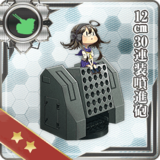 /12cm 30-tube Rocket Launcher Kai Ni
/12cm 30-tube Rocket Launcher Kai Ni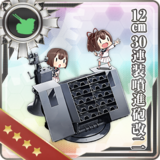
- RP - Ranking points
- RSC - Resources
- RNG - Random Number Generation
- SCAMP - Skilled Carrier-based Aircraft Maintenance Personnel

- SE - Support Expedition
- SF - Striking Force Fleet
- SFCF - Striking Force Fleet Command Facility

- SLO - Skilled Lookouts


- SSLO - "Super Skilled Lookouts
 "
"
- SSLO - "Super Skilled Lookouts
- SONAR - SOund Navigation And Ranging
- SPB - Sea Plane Bomber
- SPF - Sea Plane Fighter
- SS - Submarine
- SSV - Aicraft Carrying Submarine
- STF - Surface Task Force
- TCI - Torpedo Cut In
- TCF/TE - Transport Combined Fleet / Transport Escort
- TP - "Transport Points"
- TSSL - Torpedo Squadron Skilled Lookouts

- TTK - "Teitoku", Japaneses for "Admiral"
- VA - Voice Actress, same as CV
- WG/WG42 - WG42 (Wurfgerät 42)

- YKKZ - Yukikaze
- YMKZ - Yamakaze
Abbreviations, Specific terms & Trivia
Alongside acronyms, you may encounter some abbreviations, specific terms, and trivia, some being Japanese terms or names, more practical names referring to specifics in-game features, or even real-life Trivia.
- 2-4-11 - Naka. 2-4-11 refers to the fuel-ammo-steel combination received from her scrap (if scrapping with her default equipment).
- Beaver - Yukikaze's nickname based on her appearance. Japanese call her 'Hamster'.
- Big Seven - Refers to the firsts 7 battleships built to carry the biggest naval gun (>40 cm) allowed by the Washington Naval Treaty, namely, the Nagato-class, Nelson-class, and Colorado-class.
- Blow torches - Instant Construction Material
- BRS nicknames :
- Black Rick Shooter - Heavy Cruiser Ri-Class Kai
- Black Ruck Shooter - Battleship Ru-Class Kai
- Black Wock Shooter - Standard Carrier Wo-Class Kai Flagship
- Bucket - Instant Repair Material
- Bulldozer - Construction Corps
- BURNING LOVE - Notable line from Kongou
- C2 - Studio/Dojin circle behind Kancolle
- Chuuha - "very damaged", orange damaged
- Cranes - Shoukaku-class, both being named after cranes
- Dev mat - Development materials
- Dragons - Souryuu, Hiryuu, and Unryuu, all three being named after dragons
- Ducks - Akizuki-class
- Flamethrower - Instant Construction Material
- Green T - Crossing the T (Advantage) Engagement
- Kancolle - Kantai Collection
- Kanmusu - kantai musume, ship-girl
- Melon-chan - Yuubari's nickname due to her uniform color scheme and general resemblance to a melon as well as the City of Yuubari, on the namesake Yuubari River, which is well known for its melons.
- Nagamon - Nagato's name "長門" 2nd kanji, "門", can be pronounced as mon. This name contrasts Nagato's seriousness with the silly and cute things she is usually depicted doing.
- Nagamutsu - Fusion of Nagato and Mutsu names, designating the class or both of them.
- Nuke - Anti-installation setup using a tank, a DLC, and artillery, doing "nuclear-like" damages to installations (up to 9999 damages)
- Poi? (っぽい?) - Catchphrase of Yuudachi, meaning "maybe", referring to Ironbottom Sound.
- Potatoes - Every characters drawn by Shibafu (しばふ), referring to the simple "potatoes-like" shape of their face.
- Red T - Crossing the T (Disadvantage) Engagement
- Rensouhou-chan (連装砲ちゃん) - A Danbo-like robot which appears with some ships like Shimakaze. Amatsukaze having a more formal character, calls hers Rensouhou-kun instead.
- Rosa - 12cm 30-tube Rocket Launcher Kai Ni

- Screw - Improvement Materials
- Shirei-kan - "Commander"
- Strawberry - Harusame, referring to her hair color.
- Taiha - "heavily damaged", red damaged
- Tanaka - Kensuke Tanaka, creator and original programmer of Kancolle.
- Tank - Ka-Mi Tank
 , not to be confused with landing tanks
, not to be confused with landing tanks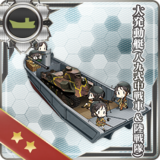
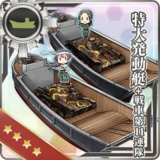
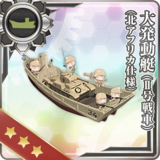
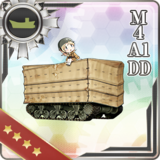
- Teitoku - "Admiral"
- Tenryuu Kindergarten - A common theme where Tenryuu and a destroyers' escort is regularly used in expeditions to optimize resources consumption. The official 4-Koma also shows Tenryuu as being good at taking care of children (destroyers).
- Torches - Instant Construction Material
- Touch - the general name used for special attacks, such as the Big Seven special attacks, the Kongo-class special attacks, and AS special attacks.
- Whales - Refer to Submarine Tenders having the kanji "鯨" meaning whale in their name.
- Yamasushi - Fusion of Yamato and Musashi names, designating the class or both of them.
- Yasen - "night battle"
- Zekamashi (ぜかまし) - Shimakaze's name read backward (in traditional Japanese, characters are read right-to-left). Found on one of the Rensouhou-chan's lifebuoys.
- !すでのな - One of Inazuma's lines written "backward", in traditional Japanese format. Also appears as a wall scroll in the furniture page.